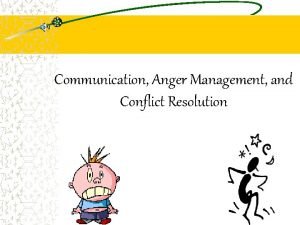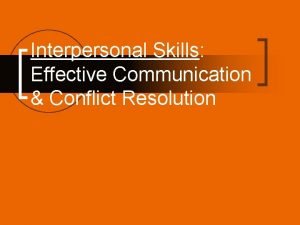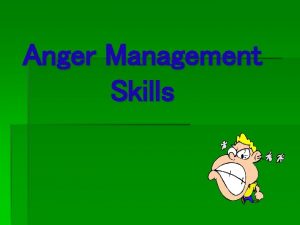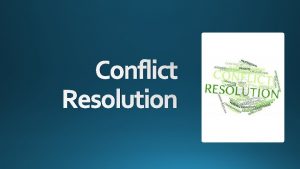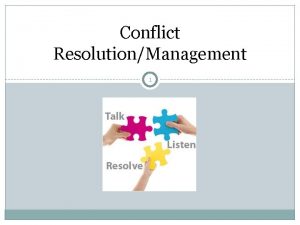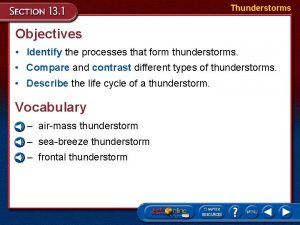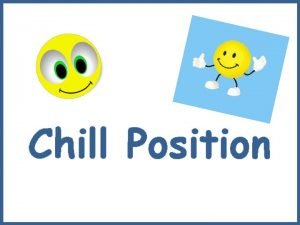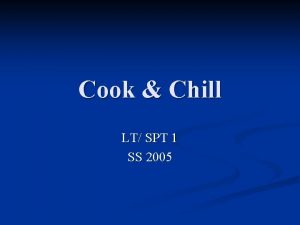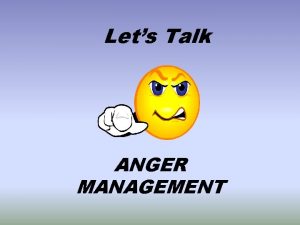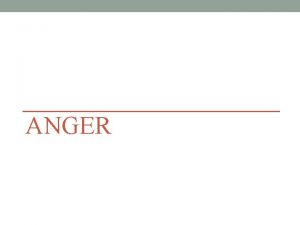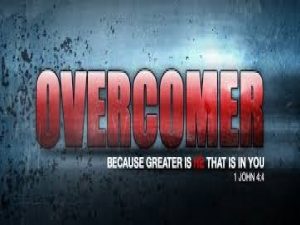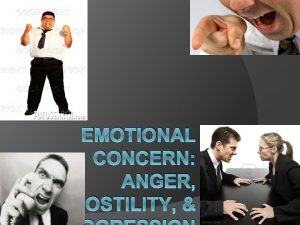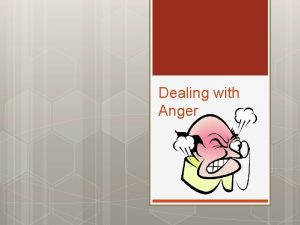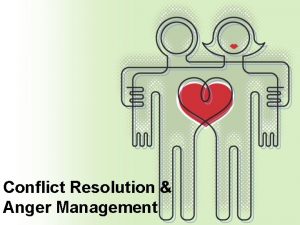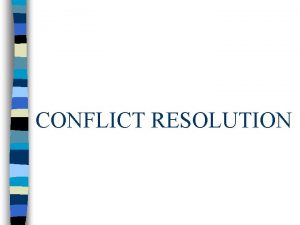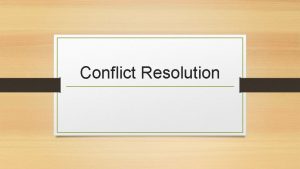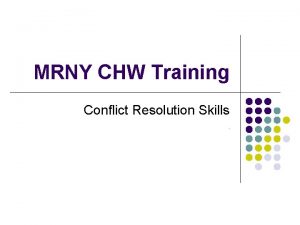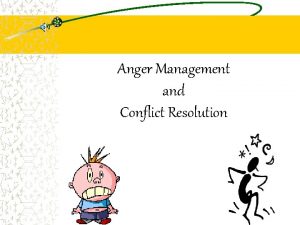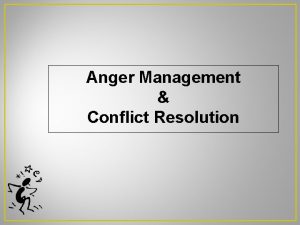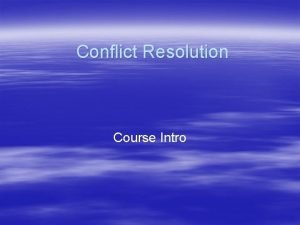Chill Skills Anger Management and Conflict Resolution for
























- Slides: 24

Chill Skills: Anger Management and Conflict Resolution for Professionals Deborah Thomason Ed. D. , CFLE Professor & Extension Specialist Clemson University

Conflict is a natural part of life. It is a normal outcome of human interaction. Yet most of us have negative associations with conflict. We tend to think of conflict in terms of anger, hostility, violence, stress, and fear

Individuals react to conflict in a variety of ways based on their prior experiences. Research indicates that conflict can result in a “winwin” situation which benefits all parties involved.

These materials are designed to provide the knowledge and skills necessary to cope in a variety of settings. The activities and content materials are designed to enable participants to improve and strengthen their skills in communication, anger management and interpersonal relationships.

NEGATIVE vs. POSITIVE Negative (-) Conflict • Interrupts normal relations • Provokes hurtful, personally harmful effects on the self-concept of the persons involved • Causes resentment and hostility • Makes rational discussion difficult or impossible • Robs the time and energy of everyone • Causes stress and resulting hardships • Causes possible break-up of relationships

NEGATIVE vs. POSITIVE Positive (+) Conflict • Helps people understand what others feel is important • Helps define and clarify issues and values • Can lead to a confrontation, which can bring out ideas, issues, and values in a way which clears the air • Can bring a sense of respect to all • Can be the start of defining adjusted or new goals, which are more satisfactory to everyone

Common Responses to Conflict • Avoidance – acknowledge a dispute, but • • move to remain uninvolved. Acceptance – recognize a conflict, but accept whatever solution emerges or is imposed. Denial – actively refuse to acknowledge or play a part in resolving a conflict. Enjoyment – some people benefit from a conflict and agitate or maintain conflict for the fun of it. Flight – actively remove oneself from a dispute.

Common Responses • Ignoring – act as if a dispute did not • • • exist. Management – acknowledge a dispute, and act to control its impact. May or may not address any of the stated or underlying issues. Promotion – parties with a serious grievance and little power may feel they need to agitate to get their problems heard. Suppression – powerful parties may use their influence to deny a problem and prevent a grievance from surfacing.

Conflict Styles

Styles of Conflict Resolution Forcing, Competing (SHARK) Use of power te a i d e m m i s d t e h e e r g n i a r t s a y e h a t k w a t is n s s i o r d ; n C n a o y t i r s b i e u s v p i s dec nd do i h l s a n o o o i g y at l be high; e r t u y b r t ve n a t r o p im t. o n are

Styles of Conflict Resolution Collaborating (OWL) Groups problem-solve together; bring up all relevant info; all parties recognize the abilities and expertise of the others; issue explored from all angles. ry a s s e c e n is s e i nt n tim is e m e tise t i h m s; w n r e e m h p ; w o e y x c l d e i h n s n ides g e i e h h h t h o l; w W e s r b a h t m a s o o c p i r b i t f i h r m s c o n not ded fr elatio r e e d n n. a l goa ortant imp

Styles of Conflict Resolution Compromising, Negotiation (FOX) Bargaining; meeting each other half way lly a u t u m g n y i r v a e s i s h e c c a e f n o ; t e l p u o No h ctory res -lose fa in s i w e t r a a a l s ta p e i s c h r e s r u n o i t to fo on; reso a l e. r e i d c t n n a a l rta a situ o o p g m ; i d e e t t i era lim d o m f o e ar

Styles of Conflict Resolution Withdrawal, Avoiding (TURTLE) Attempting to get rid of conflict by denying it exists o o t e u s s i d i ; r o e v v a o o t g r n i e t. f t h e n r g i a p f t r s h t o e r p d o i m s w i t t h t a o o n th b e t ; u o e l s n Is s nd p a i h h s o t n t o i o t h la e r ; e u s s i

Styles of Conflict Resolution Smoothing, Accommodating (TEDDY BEAR) Giving in and giving all er h t i s e i o n t r t u t n e a t r r n o i p r o m i t v a t a f h o t n e r n s i u ; o i t y t e u g a f u r e tu n i e n Iss s ; e h t n f w i n o ; a w side ed; no- nt a lot import a y ir r s e a e v d w t re ’. a e n c s s e n do onship porta ti m i a l f e o r ot n l goa

Communication Blockers • Interrupting – Good communication is not possible when people are cut off before they have finished speaking. It is important that everyone tells their side. • Ignoring – Forms of ignoring can be not paying attention, monopolizing the conversation, focusing on one’s agenda brushing off what someone is saying. • Sarcasm – Sarcasm is a real communication killer. It poisons the atmosphere.

Communication Blockers • Accusing – Accusations are counter productive. The accused party usually becomes angry and defensive. • Insulting/Name-Calling/Threatening – Aggressive attacks raise hostility and increase the chances for violence. • Globalizing – Globalizing attaches negative labels to people. Global statements are hardly ever accurate, and they make people angry and defensive.

Communication Blockers • Judging – Judging occurs when someone • • • assumes the right to decide if others are right or wrong, good or bad. Blaming – Blamers assume that if there is a problem, somebody must be to blame. Stating Opinion as Fact – It can be infuriating to hear someone state an opinion as if it were the absolute truth. Expecting Mind-Reading – People assume that their thought and feelings are visible to others.

Keys to Understanding Anger • Anger is an emotion. • Anger is good, it’s healthy, it’s normal. • Anger can protect and motivate us. • Bottled up anger can become explosive, • • depressive and bad for your health. Violence or abuse is behavior. It can be learned and unlearned. Violence has many forms - verbal, sexual, emotional or to property. We need to know what we want and how to ask for it. Other people’s anger is their problem.

• Good self esteem means we have less need for anger. • TIME OUT is for everyone’s safety. It stops abuse but does not solve the initial problem. • Safe expression of anger is healthy. • Stating what makes us angry is healthy. • We need to learn to use words that express our anger constructively. • Learning what triggers our anger makes it easier to control. • Owning our feelings is healthy and reduces conflict.

• Behind anger there are feelings of hurt or fear of powerlessness. • We need to remember that we do not always get what we want. • Good listening helps reduce anger and increases self-esteem. • Children learn how to behave from adult models. They learn more from what adults DO than what they SAY. • Other people’s abuse does not have to be accepted.

• Treat anger as a normal part of life. • Use anger as a signal that there are • • • problems to be addressed. Take actions when necessary, but only after you have carefully thought through the situation. Express your anger in moderation, without losing control. Use anger to solve problems, not just to express their feelings. State your anger clearly, so that others can respond appropriately to your wants and needs. Solve the problem and let go of your anger.

TIPS FOR DEALING WITH ANGER • TALK ABOUT YOUR FEELINGS If you cannot find the right words to describe what you are going through, find a trusted friend to help you one-on-one. • EXPRESS YOURSELF CALMLY Express disappointment, displeasure or hurt feelings without losing your temper or fighting.

• LISTEN TO OTHERS Listen carefully and respond without getting upset when someone gives you negative feedback. Try to see the other person’s point of view. • NEGOTIATE Work out your problems with someone else by looking at alternative solutions and compromises.

SUMMARY After you decide on a solution, try it out. If it does not work to everybody’s satisfaction, try again. Keep going until you find an anger management or conflict resolution plan that works. Keep working until you reach a “Win-Win” solution.
 Anger management and conflict resolution
Anger management and conflict resolution Anger management and conflict resolution
Anger management and conflict resolution What is conflict and conflict resolution?
What is conflict and conflict resolution? Interpersonal conflict resolution skills
Interpersonal conflict resolution skills Anger cues
Anger cues Watch mastering conflict management and resolution at work
Watch mastering conflict management and resolution at work Watch mastering conflict management and resolution at work
Watch mastering conflict management and resolution at work Mastering conflict management and resolution at work
Mastering conflict management and resolution at work Compare and contrast cold wave and wind chill factor
Compare and contrast cold wave and wind chill factor Cook and chill svantaggi
Cook and chill svantaggi Managing conflict and negotiation
Managing conflict and negotiation Every good boy does fine bass clef
Every good boy does fine bass clef Imágenes del universo
Imágenes del universo A great teacher eats apples
A great teacher eats apples Cook & chill grundlagen und erfahrungen aus der praxis
Cook & chill grundlagen und erfahrungen aus der praxis Beth putnam the crucible
Beth putnam the crucible Second degree frostbite
Second degree frostbite The chill project
The chill project Weaving welding definition
Weaving welding definition High resolution low resolution
High resolution low resolution Center for african peace and conflict resolution
Center for african peace and conflict resolution The setting in the necklace
The setting in the necklace The alchemist conflict and resolution
The alchemist conflict and resolution The treasure of lemon brown author
The treasure of lemon brown author Anger management goals and objectives
Anger management goals and objectives
